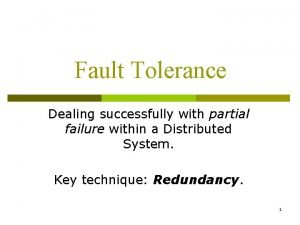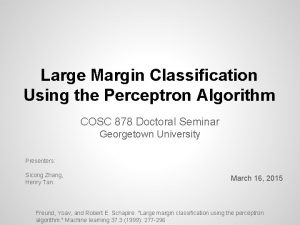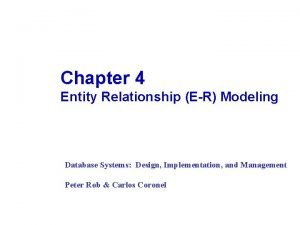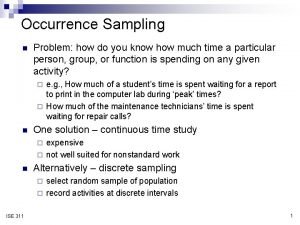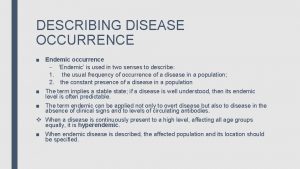Predicting Depression Occurrence Using Classification Algorithm in Data

















- Slides: 17

Predicting Depression Occurrence Using Classification Algorithm in Data Mining Abdur Rahman Department of Statistics Shahjalal University of Science and Technology Sylhet, Bangladesh E-mail: airdipu@gmail. com

Introduction • Universal definition of old age is elusive • Only 6. 13 percent is elder (60+) in Bangladesh • Become senile and lose ability in physically and mentally • Aging is one of the embryonic problems in Bangladesh • Self-assessments of health are common components of populationbased surveys • Elderly are found to suffer from diseases like depression, sleeping problem, gastric problem, diabetes, mental problem and so on

Methodology • Linear Discriminant Analysis (LDA) • Quadratic Discriminant Analysis (QDA) • Logistic Regression Analysis • K-Nearest Neighbor (KNN)

Figure: Architecture of Classification Algorithm

Sampling Method • Cluster sampling • Urban area, rural area, tea garden area and ethnic area • Collected whole population from each cluster

Data • Primary data • Collected during March to September 2015 • 229 elderly peoples aged ranges from 60 to 60+ • Face to face personal interviews through questionnaires

Linear Discriminant Analysis LDA undertakes the same task as Logistic Regression. It classifies data based on categorical variables • • Making profit or not Buy a product or not Satisfied customer or not Political party voting intention

Linear Discriminant Analysis • LDA involves the determination of linear equation (just like linear regression) that will predict which group the case belongs to. Here • • D: discriminant function v: discriminant coefficient or weight for the variable X: variable a: constant

Quadratic Discriminant Analysis • Quadratic discriminant analysis calculates a Quadratic Score Function This is a function of population mean vectors and the variancecovariance matrices for the ith group

Logistic Regression • In logistic regression, the dependent variable is binary or dichotomous, i. e. it only contains data coded as 1 (TRUE, success, pregnant, etc. ) or 0 (FALSE, failure, nonpregnant, etc. ) • The logit transformation is defined as the logged odds

KNN • KNN is completely non-parametric: No assumptions are made about the shape of the decision boundary! • We can expect KNN to dominate both LDA and Logistic Regression when the decision boundary is highly non-linear • The most intuitive nearest neighbour type classifier is the one nearest neighbour classifier that assigns a point x to the class of its closest neighbour in the feature space, that is

Figure: Error Rate for Different Value of K

Results & Discussions • If the true decision boundary is • Linear: LDA and Logistic outperforms • Moderately Non-linear: QDA outperforms • More complicated: KNN is superior

Results & Discussions Correctly Classified Misclassified (%) QDA 93. 67 6. 33 LDA 94. 94 5. 06 Logistic Regression 94. 94 5. 06 KNN 98. 73 1. 27

Chart Title KNN Logistic Regression LDA QDA 92. 7 93. 7 94. 7 95. 7 Correctly Classified (%) 96. 7 97. 7 98. 7 Misclassified (%) Figure: Graphical Representation of Accuracy 99. 7 100. 7

Conclusions • LDA and Logistic regression shows same accuracy • QDA performs lowest accuracy • KNN is better than LDA, QDA and Logistic regression

THANK YOU
 Partial failure
Partial failure Predicting nba games using neural networks
Predicting nba games using neural networks Margin perceptron algorithm
Margin perceptron algorithm Co occurrence matrix example
Co occurrence matrix example Co occurrence matrix example
Co occurrence matrix example Gypsum occurrence
Gypsum occurrence Express action or state of being
Express action or state of being Occurrence of silicon
Occurrence of silicon Annual exceedance probability vs return period
Annual exceedance probability vs return period Cardinality and connectivity
Cardinality and connectivity Examples of irony in an occurrence at owl creek bridge
Examples of irony in an occurrence at owl creek bridge An occurrence at owl creek bridge pov
An occurrence at owl creek bridge pov An occurrence at owl creek bridge tone
An occurrence at owl creek bridge tone Climax of an occurrence at owl creek bridge
Climax of an occurrence at owl creek bridge It is an occurrence of harmony
It is an occurrence of harmony Occurrence sampling
Occurrence sampling Abstraction-occurrence design pattern
Abstraction-occurrence design pattern Occurrence of zinc
Occurrence of zinc
